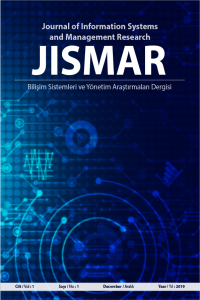Öz
Smart cities
have attracted an extensive and emerging interest from both science and
industry with an increasing number of international examples emerging from all
over the world. However, despite the significant role that smart cities can
play to deal with recent urban challenges, the concept has been being
criticized for not being able to realize its potential and for being a vendor
hype. This study explores the evolution of smart city application research
lines in the especially, application as a scientific field. To this end,
co-word analysis is employed for 472 smart city articles related to their
applications field that were published in management information systems and
management application focused journals and business/ management journals. The research
lines indicate that the “internet of things” has the highest usage percentage,
followed by “big data analytics”, “information communication systems” and “city
application”. Research lines, such as security, mobile applications, renewable
energy, receive minimal interest amongst researchers. The current study is
amongst the first in this field that discusses how research lines in the field
could be advanced. Moreover, this paper reviews different conceptualization,
benchmarks and evaluations of the smart city application concept.
Anahtar Kelimeler
Kaynakça
- [1] Cellary, Wojciech. "Smart governance for smart industries." Proceedings of the 7th International Conference on theory and practice of electronic governance. ACM, 2013.
- [2] ISO, ISO. "37120 sustainable development of communities―indicators for city services and quality of life." (2014).
- [3] Ranjani, Siva, and Sasi Kala. "Design of Digital Circuits for ECG Data Acquisition System Using 90nm CMOS Technology." Asian Journal of Applied Science and Technology (AJAST) Volume 1 (2017): 79-84.
- [4] Cataldo, Franca. An analysis of United States K-12 stem education versus STEM workforce at the dawn of the digital revolution. Diss. Utica College, 2014.
- [5] Schaffers, Hans, Carlo Ratti, and Nicos Komninos. "Special issue on smart applications for smart cities-new approaches to innovation: Guest editors’ introduction." Journal of theoretical and applied electronic commerce research 7.3 (2012): ii-v.
- [6] Vermesan, Ovidiu, and Peter Friess, eds. Internet of things-from research and innovation to market deployment. Vol. 29. Aalborg: River publishers, 2014.
- [7] Cohen, Barney. "Urbanization, City growth, and the New United Nations development agenda." Cornerstone 3.2 (2015): 4-7.
- [8] Caragliu, Andrea, Chiara Del Bo, and Peter Nijkamp. "Smart cities in Europe." Journal of urban technology 18.2 (2011): 65-82.
- [9] Cocchia, Annalisa. "Smart and digital city: A systematic literature review." Smart city. Springer, Cham, 2014. 13-43.
- [10] Anthopoulos, L., Janssen, M., & Weerakkody, V. (2019). A Unified Smart City Model (USCM) for smart city conceptualization and benchmarking. In Smart Cities and Smart Spaces: Concepts, Methodologies, Tools, and Applications (pp. 247-264). IGI Global.
- [11] Nam, Taewoo, and Theresa A. Pardo. "Smart city as urban innovation: Focusing on management, policy, and context." Proceedings of the 5th international conference on theory and practice of electronic governance. ACM, 2011.
- [12] Nam, Taewoo, and Theresa A. Pardo. "Conceptualizing smart city with dimensions of technology, people, and institutions." Proceedings of the 12th annual international digital government research conference: digital government innovation in challenging times. ACM, 2011.
- [13] Söderström, Ola, Till Paasche, and Francisco Klauser. "Smart cities as corporate storytelling." City 18.3 (2014): 307-320.
- [14] Brown, Lawrence A. "The city in 2050: A kaleidoscopic perspective." Applied Geography 49 (2014): 4-11.
- [15] Ray, Gautam, Waleed A. Muhanna, and Jay B. Barney. "Information technology and the performance of the customer service process: A resource-based analysis." MIS quarterly (2005): 625-652.
- [16] Graham, S., & Aurigi, A. (1997). Urbanising cyberspace? The nature and potential of the virtual cities movement. City, 2(7), 18-39.
- [17] Van den Besselaar, Peter, and Dennis Beckers. "Demographics and sociographics of the digital city." Community Computing and Support Systems. Springer, Berlin, Heidelberg, 1998. 108-124.
- [18] Lee, Jung Hoon, Marguerite Gong Hancock, and Mei-Chih Hu. "Towards an effective framework for building smart cities: Lessons from Seoul and San Francisco." Technological Forecasting and Social Change 89 (2014): 80-99.
Ayrıntılar
| Birincil Dil | İngilizce |
|---|---|
| Bölüm | Cilt 1 - Sayı 1 - 30 Aralık 2019 |
| Yazarlar | |
| Yayımlanma Tarihi | 30 Aralık 2019 |
| Yayımlandığı Sayı | Yıl 2019 Cilt: 1 Sayı: 1 |


